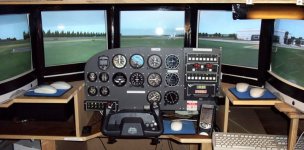Bricklayer
Member
I'm a Mech-E. I do HVAC, but flight sims are my hobby. I'm building a F-16 ****pit(pit) and am looking to use a SLC 500 type PLC to do the I/O <-> between the PC and pit's dials, switches, analog instruments, and motion system. I'd like to buy the stuff used(cheap) on eBay.
The flight sim software runs on a Windows PC and uses a "shared memory" or "mem_mapped_file" to exchange date. A small background app. reads and writes data to/from the main program.
The I/O list is roughly as follows:
I'd like to get a max latentcy of updates to the PC of no greater than 20 msec for the analog I/O. The digital could be 10x slower.
Here are my questions:
Am I in the right ballpark for a family of PLC?
Is there anything I'm overlooking in the above?
Can I use the older SLC 5/0x systems that use the serial RS-232/484 protocols? Or do I need to go with the much more expensive Ethernet systems?
Could you point me to good literature that explains comm protocols between PCs and PLCs?
Any help here would be greatly appreciated.
Craig
The flight sim software runs on a Windows PC and uses a "shared memory" or "mem_mapped_file" to exchange date. A small background app. reads and writes data to/from the main program.
The I/O list is roughly as follows:
- Digital inputs - 350
- Digital outputs - 250
- High resolution analog inputs (>=12-bit) - 8
- Low resolution analog inputs (>=8-bit) - 16
- High resolution analog outputs (>=12-bit) - 16
- Low resolution analog outputs (>=8-bit) - 16
- Rotary encoder inputs - 8
I'd like to get a max latentcy of updates to the PC of no greater than 20 msec for the analog I/O. The digital could be 10x slower.
Here are my questions:
Am I in the right ballpark for a family of PLC?
Is there anything I'm overlooking in the above?
Can I use the older SLC 5/0x systems that use the serial RS-232/484 protocols? Or do I need to go with the much more expensive Ethernet systems?
Could you point me to good literature that explains comm protocols between PCs and PLCs?
Any help here would be greatly appreciated.
Craig






